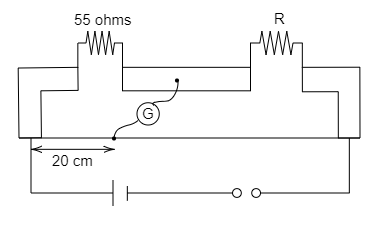
What is the value of unknown resistance $R$, if the galvanometer shows null deflection in the given meter bridge set up shown in the fig?

(A) $97.50\,\Omega $
(B) $105\,\Omega $
(C) $220\,\Omega $
(D) $110\,\Omega $

Answer
552k+ views
Hint: The value of the unknown resistance can be determined by using the wheatstone bridge principle. The wheatstone bridge principle shows the relation between the resistance which are connected in the circuit. By using the wheatstone bridge principle, the unknown resistance is determined.
Useful formula:
The wheatstone bridge principle is given by,
$\dfrac{{{R_1}}}{{{R_2}}} = \dfrac{{{R_3}}}{{{R_4}}}$
Where ${R_1}$, ${R_2}$, ${R_3}$ and ${R_4}$ are the resistance which are connected in the same circuit.
Complete answer:
Given that,
The resistance of the first resistor is, ${R_1} = 20k\,\Omega $,
Where, $k$ is the resistance per unit length. The one end of the galvanometer is connected in $20\,cm$ length. And assume the total length is $100\,cm$.
The resistance of the second resistor is, ${R_2} = 55\,\Omega $,
The resistance of the third resistor is, ${R_3} = 80k\,\Omega $,
The resistance of the fourth resistor is, ${R_4} = R\,\Omega $.
Now,
The wheatstone bridge principle is given by,
$\dfrac{{{R_1}}}{{{R_2}}} = \dfrac{{{R_3}}}{{{R_4}}}\,.....................\left( 1 \right)$
By substituting the four resistance values in the above equation, then the above equation is written as,
$\dfrac{{20k}}{{55}} = \dfrac{{80k}}{R}$
By cancelling the same terms in the above equation, then the above equation is written as,
$\dfrac{{20}}{{55}} = \dfrac{{80}}{R}$
By rearranging the terms in the above equation, then the above equation is written as,
$R = \dfrac{{80 \times 55}}{{20}}$
By multiplying the terms in the above equation, then the above equation is written as,
$R = \dfrac{{4400}}{{20}}$
By dividing the terms in the above equation, then the above equation is written as,
$R = 220\,\Omega $
Hence, the option (C) is the correct answer.
Note:
If the galvanometer shows the null deflection, then the given circuit is considered as the wheat stone bridge because in the wheatstone bridge, there are four resistors connected and it will be balanced on both sides. The same logic is used here.
Useful formula:
The wheatstone bridge principle is given by,
$\dfrac{{{R_1}}}{{{R_2}}} = \dfrac{{{R_3}}}{{{R_4}}}$
Where ${R_1}$, ${R_2}$, ${R_3}$ and ${R_4}$ are the resistance which are connected in the same circuit.
Complete answer:
Given that,
The resistance of the first resistor is, ${R_1} = 20k\,\Omega $,
Where, $k$ is the resistance per unit length. The one end of the galvanometer is connected in $20\,cm$ length. And assume the total length is $100\,cm$.
The resistance of the second resistor is, ${R_2} = 55\,\Omega $,
The resistance of the third resistor is, ${R_3} = 80k\,\Omega $,
The resistance of the fourth resistor is, ${R_4} = R\,\Omega $.
Now,
The wheatstone bridge principle is given by,
$\dfrac{{{R_1}}}{{{R_2}}} = \dfrac{{{R_3}}}{{{R_4}}}\,.....................\left( 1 \right)$
By substituting the four resistance values in the above equation, then the above equation is written as,
$\dfrac{{20k}}{{55}} = \dfrac{{80k}}{R}$
By cancelling the same terms in the above equation, then the above equation is written as,
$\dfrac{{20}}{{55}} = \dfrac{{80}}{R}$
By rearranging the terms in the above equation, then the above equation is written as,
$R = \dfrac{{80 \times 55}}{{20}}$
By multiplying the terms in the above equation, then the above equation is written as,
$R = \dfrac{{4400}}{{20}}$
By dividing the terms in the above equation, then the above equation is written as,
$R = 220\,\Omega $
Hence, the option (C) is the correct answer.
Note:
If the galvanometer shows the null deflection, then the given circuit is considered as the wheat stone bridge because in the wheatstone bridge, there are four resistors connected and it will be balanced on both sides. The same logic is used here.
Recently Updated Pages
Why are manures considered better than fertilizers class 11 biology CBSE

Find the coordinates of the midpoint of the line segment class 11 maths CBSE

Distinguish between static friction limiting friction class 11 physics CBSE

The Chairman of the constituent Assembly was A Jawaharlal class 11 social science CBSE

The first National Commission on Labour NCL submitted class 11 social science CBSE

Number of all subshell of n + l 7 is A 4 B 5 C 6 D class 11 chemistry CBSE

Trending doubts
What is meant by exothermic and endothermic reactions class 11 chemistry CBSE

10 examples of friction in our daily life

One Metric ton is equal to kg A 10000 B 1000 C 100 class 11 physics CBSE

1 Quintal is equal to a 110 kg b 10 kg c 100kg d 1000 class 11 physics CBSE

Difference Between Prokaryotic Cells and Eukaryotic Cells

What are Quantum numbers Explain the quantum number class 11 chemistry CBSE




